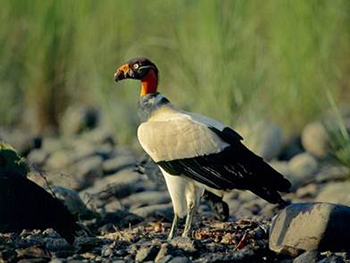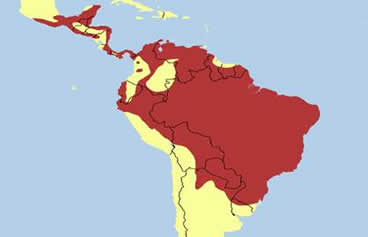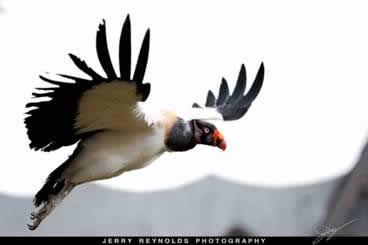King Vulture
Sarcoramphus papa

Taxonomy
Kingdom Animalia
Phylum Chordata
Class Aves
Order Falconiformes
Family Cathartidae
General Description
The King Vulture, the most brilliantly colored of the New World vultures, has varying hues ranging from purple and blue to red and orange on its head. It has a wing span that can be up to six feet, and its beak is more curved than the other species of vultures. It’s been given the more powerful features to feed upon the toughest animal carcasses, hence the name. This vulture has a cream or white color on the front of its body and back. About halfway down, it turns into a black color. It has a head that is red and an orange neck. Wattles decorate the side of the head and the back of its neck. Its wings are mostly white with black tips. The ruff, flight, and tail feathers are grey to black. From head to tail, this vulture is about 28-32 inches. An adult King Vulture can weigh from six to ten pounds. There are no differences between the males and females of this species. Because of its superior size, vibrant color, and adapted features, this bird has been coined “king.” Other birds treat it as such. When the King Vulture flies in, other birds stop feeding and allow it to eat.
Life History/Ecology

Habitat/Location
This “king” bird inhabits multiple parts of South America ranging to Central America. Both Mexico and Argentina contain the majority of these vultures. It is usually associated with lowland tropical forests but can also be found in savannas, grasslands, and desert margins. The vulture prefers to have an open feeding ground where access and quantity to food is plenty. This is the primary factor in choosing its habitat.
Resources

If it’s dead, the “king” wants it. It has no apparent sense of smell and finds carcasses through the activity of other vultures. Its curved bill allows it to feed on much larger carcasses than the other vultures. It consumes carrion whether it is rotten or fresh. The ability to eat this without becoming ill makes this vulture a necessity to the balance of nature. King Vultures are scavengers and are not known to kill any animals, not even ones on the verge of death.
Reproduction
Depending on the location, breeding season varies among the King Vultures. The vultures court each other loudly by whistling, wheezing, snorting, hissing, flapping wings, and circling each other. After mating, the female lays one white egg in a chosen hollow tree stump or less likely on a tree above ground. The male and female both take turns taking care of the egg for about two months or until it hatches. The male vulture brings back regurgitated carrion for both the female and the new hatchling. At the young stages, the hatchling eats out of the male’s beak, but later on, the male leaves the regurgitated carrion on the ground. Nearly three months after birth, the new vulture has all of its flight feathers and can fly from the hollow stump. It remains dependent on its parents for eight months and may stay close for another two years. When it is three to four years old, it has developed all of its feathers, plumage, and features.
Behavior
The King Vulture is seldom seen in large groups and usually visits carcasses in a pair or with its single offspring where they easily dominate the smaller vultures. When it is not resting in a tall canopy, it travels at high altitudes searching for food. Because they are so mighty, King Vultures often follow other birds towards carcasses and then scare the birds away. They are not migratory and are seen in the same areas all year long.
Research
A study was conducted in 1986 in hopes to prevent further reduction in King Vultures in the wild because these vultures were either feeding on the road or were not feeding at all. The research was started by teaching an eight month old King Vulture behavioral feeding and spotting techniques. While raised in captivity, the vulture was allowed to watch other birds feed on carrion. As the young King Vulture learned, it was given more freedom. The captivated King Vultures were let out into the wild after training, and the research became a success, resulting in higher prevention of reduction.
Economic/Ecological Service
It cites III status in Honduras but is not globally threatened. King Vultures face no serious threat other than deforestation. As stated above, the King Vulture does nature a great service by recycling nutrients and energy from carrion and carcasses when very few other living things are able to. They are appreciated in artwork due to their colors.
External Links
Please note that the following external links may have either been removed or relocated by the webpage owners since the time this student report was created.
http://animaldiversity.ummz.umich.edu/accounts/Sarcoramphus_papa/ lots of good information and pictures
http://www.arkive.org/king-vulture/sarcoramphus-papa/ lots of pictures
Literature Cited
Please note that the following references may have either been removed or relocated by the webpage owners since the time this student report was created.
Beletsky, Les. Travellers’ Wildlife Guides Belize, edited by Filadelpho Chable, Simon Comerford, Richard Francis, Brian Helmuth, Jon Lyon, and Briana Timmerman. Interlink Publishing Group, MA: 2010.
Clinton-Eitniear, Jack. King Vulture Conservation and Research Program Vol 3 No.5. Endangered Species Technical Bulletin. School of Natural Resources. University of Michigan. Web. May 31, 2013. http://deepblue.lib.umich.edu/bitstream/handle/2027.42/39241/als9527.0003.005.pdf?sequence=1
Grzimek’s Animal Life Encyclopedia, 2nd edition. Volumes 8-11, Birds I-IV, edited by Michael Hutchins, Jerome A. Jackson, Walter J. Bock, and Donna Olendorf. Farmington Hills, MI: Gale Group, 2002.
"King Vulture." Encyclopedia Of Animals (2006): 1. Middle Search Plus. Web. 31 May 2013.
“King Vulture.” National Geographic.com. National Geographic. Web. 31 May 2013 at http://animals.nationalgeographic.com/animals/birds/king-vulture/
“King Vulture.” BioExpedition.com. BioExpedition. Web. 31 May 2013 at http://bioexpedition.com/king-vulture/
Ormiston, D. 2003. "Sarcoramphus papa" (On-line), Animal Diversity Web. Accessed May 31, 2013 at http://animaldiversity.ummz.umich.edu/accounts/Sarcoramphus_papa/